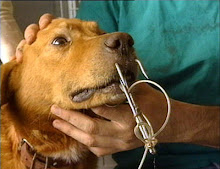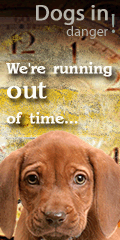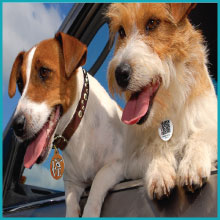Big Pets Get Bigger: Latest Survey Shows US Dog and Cat Obesity Epidemic Expanding
54 Percent of Nation's Pets Overweight According to Latest Veterinary Survey; Pet Owners in Denial
The "fat pet gap" continues to widen according to the latest nationwide survey conducted by the Association for Pet Obesity Prevention (APOP). The fifth annual veterinary survey found 53 percent of adult dogs and 55 percent of cats to be classified as overweight or obese by their veterinarian. That equals 88.4 million pets that are too heavy according to veterinarians.
"The most distressing finding in this year's study was the fact that more pet owners are unaware their pet is overweight," comments APOP founder Dr. Ernie Ward. "Twenty-two percent of dog owners and 15 percent of cat owners characterized their pet as normal weight when it was actually overweight or obese. This is what I refer to as the 'fat pet gap' or the normalization of obesity by pet parents. In simplest terms, we've made fat pets the new normal."
Perhaps even worse was the finding that the number of obese pets, those at least 30 percent above normal weight or a body condition score (BCS) of 5, continues to grow despite 93.4 percent of surveyed pet owners identifying pet obesity as a problem. The study found 24.9 percent of all cats were classified as obese and 21.4 percent of all dogs were obese in 2011. That's up from 2010 when 21.6 percent of cats and 20.6 percent of dogs were found to be obese. "What this tells us is that more and more of our pets are entering into the highest danger zone for weight-related disorders," says Ward.
Some of the common weight-related conditions in dogs and cats include osteoarthritis, type 2 diabetes, high blood pressure, breathing problems, kidney disease, and shortened life expectancy. Orthopedic surgeon, APOP Board member and Director of Clinical Research at the University of Georgia College of Veterinary Medicine Dr. Steve Budsberg states, "The prevention of obesity needs to be at the forefront of all discussions people have about the health of their pet with their veterinarian. The body of evidence that shows the negative impact of obesity on all the body's systems is overwhelming. As an orthopedic surgeon I see, on a daily basis, the effects of obesity on dogs and cats with osteoarthritis. It is very frustrating to see how much pain and discomfort excess weight has on my patients. Veterinarians and owners have the ability to stop obesity in our pets. No animal goes to the refrigerator or the pantry and helps themselves. We enable our pets to get fat!"
Ward agrees. "Pet obesity is plainly a people problem, not a pet problem. The most important decision pet owners make each day regarding their pet's health is what they choose to feed it."
Endocrinologist and fellow APOP Board member Dr. Mark Peterson agrees. "Obesity in dogs and cats is not just the accumulation of large amounts of adipose tissue, but it is associated with important metabolic and hormonal changes in the body. For example, heavy or obese cats are up to four times more likely to develop diabetes as a complication of their obesity. Losing weight can lead to reversal of the diabetic state in some of these obese cats."
Treats continue to be a major contributor to weight gain in pets. An online poll conducted in October 2011 by APOP of 210 pet owners found 93 percent of all dog and cat owners gave treats. Ninety-five percent gave a commercial treat with 26 percent reporting they gave their pet treats three or more times a day. "Treats are the silent saboteur of slimming down," remarks Ward. "Those tiny treats often are hiding a significant amount of calories." Ward suggests offering single-ingredient rewards or fresh vegetables such as baby carrots, string beans, broccoli or other crunchy vegetables.
Veterinary nutritionist and internal medicine specialist Dr. Joe Bartges from the University of Tennessee College of Veterinary Medicine and APOP Board member notes that weight gain in pets can be prevented. "Prevention of obesity is much easier than treating it. The major obstacle is to convince pet owners what 'overweight' and 'obese' mean and what it looks like. Veterinary health teams must educate the owner and work with them to prevent and treat obesity in their four-legged family members."
Fat Cats Not In the Conversation
Only 49 percent of surveyed cat owners reported their veterinarian had discussed obesity and excess weight with them compared to 72 percent of dog owners. Even worse, only 46 percent of cat owners stated their veterinarian had reviewed nutrition or food choices compared to 86 percent of those with dogs. "This is a call to action for veterinarians; we must do a better job educating cat owners on obesity and preventive care," says Dr. Ernie Ward.
Survey Notes
The survey was conducted at 41 U.S. veterinary clinics and evaluated 459 dogs and 177 cats in October 2011. Veterinarians and veterinary technicians evaluated each pet to assess current weight, medical conditions, owner assessment of weight and body condition score. Over the five years studied, these results have proven to be consistent and increasing at a gradual pace.
Additional Survey Highlights
•According to APOP's survey results based on pet statistics from the American Pet Products Association, the following are estimated numbers of overweight and obese pets in 2011.
•41.1 million dogs classified as overweight or obese (BCS 4 or 5)
•52% adult dogs classified as overweight or obese (BCS 4 or 5)
•24.4 million dogs or 31% reported as overweight (BCS 4)
•16.7 million dogs or 21% reported obese (BCS 5)
•47.4 million cats classified as overweight or obese (BCS 4 or 5)
•55% adult cats classified as overweight or obese (BCS 4 or 5)
•25.9 million cats or 31% reported as overweight (BCS 4)
•21.5 million cats or 21% reported obese (BCS 5)
•Only 8% of dog owners and 9% of cat owners classified their pet as obese in the online study. That's less than half the actual figures determined by survey veterinarians. "The fact that few pet owners admit their pet is obese leads to a lack of interest in helping their pet lose weight. They know it's a problem, just not for their pet. Unfortunately, the data doesn't agree. Chances are their pet is overweight if not obese," Dr. Ernie Ward
•Average age of the cats in the study was 6.7 years and 6.4 years for dogs.
•16.8% of pet owners reported they purchased their pet food at a veterinary clinic, 61.1% at a pet store and 22.2% at a grocery store.
•76% of surveyed pet owners reported they learned about pet nutrition from their veterinarian, 71.5% from the Internet, 22% from a pet store, 5.5% from a breeder, and 2.0% from a groomer. (multiple sources of information were allowed)
•When it came to deciding which pet food to feed, 69.4% trusted their veterinarian, 36.3% a website, 20.6% a pet store, 4.4% a breeder, and 1.3% their groomer.
•According to Dr. Ernie Ward, a 95-pound male Golden retriever is comparable to a 5'4" human female weighing 184 pounds or a 5'9" male who weighs 214 pounds.
•A 10-pound Chihuahua is comparable to a 5'4" human female weighing 242 pounds or a 5'9" male who weighs 282 pounds.
•A 15-pound domestic short-haired cat is comparable to a 5'4" human female weighing 218 pounds or a 5'9" male who weighs 254 pounds.
•A premium pig ear (231 kcals) fed to a 40-pound dog is the equivalent of an adult human drinking six 12-ounce colas (840 kcals).
•A typical dog biscuit (25 to 27 kcals) fed to a 20-pound dog is the equivalent of an average adult human eating two Keebler EL Fudge Double Stuffed Sandwich Cookies® (180 kcals).
•More weight and treat calculators can be found at www.PetObesityPrevention.org.
About APOP
Founded in 2005 by veterinarian Dr. Ernie Ward, APOP's mission is to create and promote awareness of pet obesity and to develop parallel weight loss programs designed to help pet owners lose weight alongside their pets.
The Association for Pet Obesity Prevention (APOP) has launched campaigns to fight pet obesity within the veterinary medical community, veterinary schools, and state and local veterinary organizations, and has reached out to various media outlets. APOP is made up of dedicated veterinarians and veterinary healthcare personnel committed to making the lives of dogs, cats, all other animals and people healthier and more vital.
APOP is not affiliated with any veterinary industry corporation or business in any manner. This neutrality is critical to our ability to provide unbiased information and advice to veterinary healthcare providers and the pet-loving public.
Contact
www.PetObesityPrevention.org for full biographies and additional resources and information
SOURCE Association for Pet Obesity Prevention
Subscribe to:
Post Comments (Atom)

















No comments:
Post a Comment